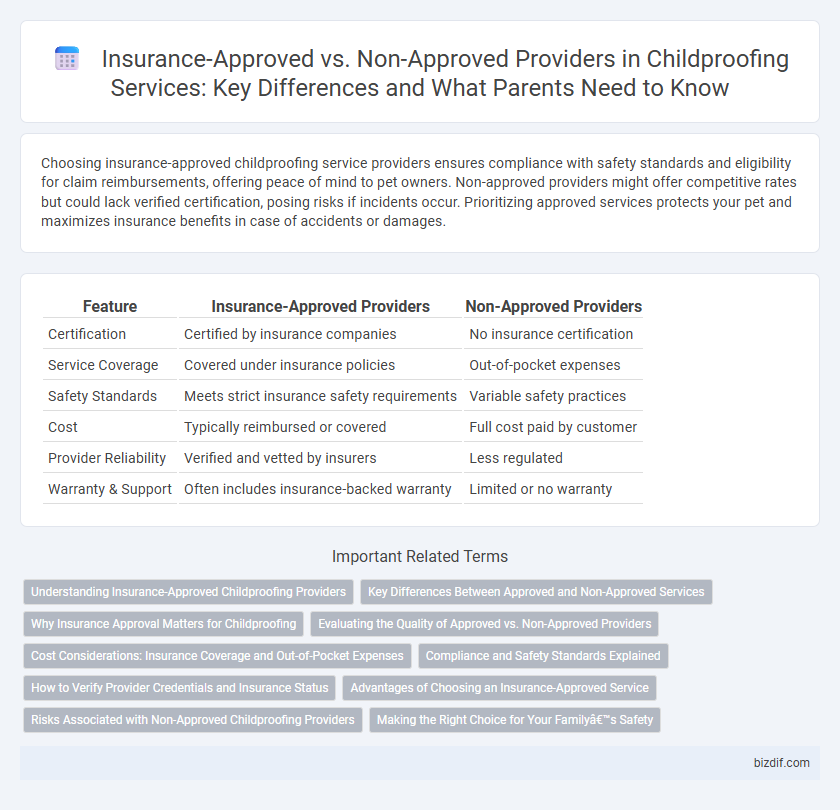Choosing insurance-approved childproofing service providers ensures compliance with safety standards and eligibility for claim reimbursements, offering peace of mind to pet owners. Non-approved providers might offer competitive rates but could lack verified certification, posing risks if incidents occur. Prioritizing approved services protects your pet and maximizes insurance benefits in case of accidents or damages.
Table of Comparison
| Feature | Insurance-Approved Providers | Non-Approved Providers |
|---|---|---|
| Certification | Certified by insurance companies | No insurance certification |
| Service Coverage | Covered under insurance policies | Out-of-pocket expenses |
| Safety Standards | Meets strict insurance safety requirements | Variable safety practices |
| Cost | Typically reimbursed or covered | Full cost paid by customer |
| Provider Reliability | Verified and vetted by insurers | Less regulated |
| Warranty & Support | Often includes insurance-backed warranty | Limited or no warranty |
Understanding Insurance-Approved Childproofing Providers
Insurance-approved childproofing providers meet rigorous safety and compliance standards set by insurers, ensuring their products and installation services reduce liability risks effectively. Choosing an insurance-approved provider guarantees adherence to industry regulations, potentially lowering insurance premiums and enhancing home safety reliability. Non-approved providers may lack standardized quality control, increasing the likelihood of product failure and nullifying insurance claims in case of accidents.
Key Differences Between Approved and Non-Approved Services
Insurance-approved childproofing providers meet strict safety standards and offer certified installation, ensuring compliance with insurance policies for liability and coverage. Non-approved services may lack professional certification and standardized safety measures, potentially resulting in unrecognized installations that could void insurance claims. Choosing approved providers guarantees peace of mind with verified protection for children and financial security through proper insurance endorsements.
Why Insurance Approval Matters for Childproofing
Insurance-approved childproofing providers meet safety standards and regulatory requirements that reduce liability risks for both families and professionals. Choosing an approved provider ensures coverage and potential reimbursement through insurance policies, offering financial protection in case of accidents or defects. Non-approved providers may lack verified compliance, resulting in denied claims and increased out-of-pocket expenses for childproofing solutions.
Evaluating the Quality of Approved vs. Non-Approved Providers
Insurance-approved childproofing providers adhere to strict safety standards and often undergo rigorous inspections to ensure compliance, delivering higher reliability and protection for children. Non-approved providers may offer more affordable options but lack the verified safety certifications and consistent quality controls that ensure effective hazard prevention. Evaluating providers based on their insurance approval status helps safeguard against potential liabilities and ensures that installed childproofing products meet established safety regulations.
Cost Considerations: Insurance Coverage and Out-of-Pocket Expenses
Insurance-approved childproofing providers often reduce out-of-pocket expenses by allowing coverage through health or home insurance plans, making safety upgrades more affordable. Non-approved providers typically require full payment upfront, increasing the financial burden on families despite potentially competitive service rates. Evaluating insurance coverage options and provider certifications can significantly impact the overall cost-effectiveness of childproofing services.
Compliance and Safety Standards Explained
Insurance-approved childproofing providers adhere to rigorous compliance and safety standards set by regulatory bodies, ensuring the use of tested and certified materials that minimize risks in home environments. Non-approved providers may lack this certification, potentially compromising safety due to unverified products and inconsistent installation practices. Selecting an insurance-approved service guarantees alignment with legal requirements and enhances protection for children against household hazards.
How to Verify Provider Credentials and Insurance Status
Verify childproofing provider credentials by requesting proof of insurance, including general liability and workers' compensation coverage, to ensure compliance with safety standards. Check for certifications from recognized safety organizations and confirm their license status through state regulatory agencies' databases. Request client references and read reviews to assess the provider's reputation and reliability in childproofing services.
Advantages of Choosing an Insurance-Approved Service
Choosing an insurance-approved childproofing service ensures compliance with safety standards and provides financial protection through coverage of potential damages or liabilities. Insurance-approved providers undergo rigorous screening, guaranteeing trained professionals who use high-quality, tested materials for child safety. This approval also facilitates claim processes, reducing out-of-pocket expenses for families in case of accidents or defects related to childproofing installations.
Risks Associated with Non-Approved Childproofing Providers
Choosing insurance-approved childproofing providers minimizes risks such as substandard safety installations and potential liability claims, ensuring compliance with industry standards and regulatory guidelines. Non-approved providers may use inferior materials or improper techniques, increasing the likelihood of accidents and injuries that insurance companies might reject for coverage. Families relying on non-certified services could face significant financial and legal consequences if child safety hazards arise due to inadequate proofing measures.
Making the Right Choice for Your Family’s Safety
Selecting an insurance-approved childproofing provider ensures compliance with safety standards and offers financial protection through coverage options in case of damages or accidents. Non-approved providers may offer lower costs but often lack verified certifications, increasing potential risks for inadequate installations or liability gaps. Prioritizing an approved service safeguards your family's safety by guaranteeing professionally verified childproofing solutions and reliable insurance backing.
Insurance-Approved vs Non-Approved Providers Infographic

 bizdif.com
bizdif.com